|
|
|
the pigs of Champerico
Saturday, March 18 2006
setting: Quetzaltenango, Guatemala
It being the weekend, Celas Maya had lined up some activities for the students, one of which Gretchen and I would be partaking of today. It would be a trip to some Mayan and pre-Mayan ruins on the other side of Volcán Santa Maria and then a visit to a Pacific beach. It would be good to get down to lands where air is dense, warm, and humid.
To begin our journey, we had to get up unusually early, before 7am. I'd somehow figured out a way to make my iBook play loud rock and roll music as an alarm, since there wasn't a single alarm clock anywhere in our house.
Because we were going to the beach, I'd decided to underdress. Normally Xela weather calls for a sweater most of the day, particularly in the morning. But today I was wearing a teeshirt and shorts. I regretted it at first, as temperatures were down in the low 50s, but once we were down on Guatemala's coastal plain it seemed like I'd made a good decision.
First, though, we had to cross a ridge of highlands that lay between the bowl of Xela (elevation 7700 ft.) and the lowlands to the south. These highlands are well over 8500 feet above sea level, and on this chilly morning there was frost visible on the grass. Though temperatures can fall below freezing at extreme elevations in Central America, the cold never continues long enough to form glaciers. (One has to go down to South America to find sufficient elevations in the tropics.)
Coming down off the highlands, we encountered several places where bridges had been washed out (by Hurricane Stan) and we were forced to take long meandering detours along the contours. On our way out onto the coastal plain, the vegetation gradually increased in lushness, though it was all still covered with dust because we were still in the late dry season. At some point we turned around to see the backside of Volcán Santa Maria and its now-visible siamese child, Santiaguito, which is an active volcano. The landscape around it was so new it looked like an ugly construction site. And Santiaguito was sending a tall plume of smoke skyward, just like in a movie about cavemen and dinosaurs.
The Mayan ruins were near the small city of Retalhuleu at a site called Abaj Takalik. Abaj Takalik was once a coffee plantation ("finca") and is only the part that has been excavated so far; many of the ancient Mayan and Olmec ruins lie beneath neighboring plantations which still grow coffee for export.
It sounded good to be seeing a Mayan/pre-Mayan ruin, but on the ground the site wasn't that impressive. Some of the carvings (as old as 3000 years in some cases) just looked like random boulders and it took a trained eye to see anything manmade about them. There were a number of good carvings, but they were outweighed by the marginal stuff. There were also a number of terraced hillsides and what not, though none of it was mind-blowing.
As if in acknowledgement of the marginal tourism potential of the ruins, near the end of the tour is a small zoo featuring monkeys, peccaries, crocodiles, turtles, and, strangely, dozens of raccoons (as well as several raccoon relatives native to the tropics).
At first Gretchen was horrified to see animals trapped this way in cages, and she raised a fuss with our Spanish-speaking guide. But he'd dealt with her kind before and had a ready answer, explaining that the animals were being rehabilitated so they could be released into the wild some day, assuming a wild still exists when they're ready to be released. This seemed to satisfy Gretchen, and she was clearly relieved to have been given license to wallow in the cuteness.
The most interesting of the animals was a monkey with a shocking-large labia. The labia was so big and flopped about so flagrantly that most onlookers mistook it for a penis and used "him" as the operative pronoun for its owner. But I knew better and set everyone straight. By that point several of us had been grabbed by Miss Labia's long prehensile tail, which she would shoot out between the bars and then wrap around your arm (or use in an attempt to steal your camera). She could be similarly crafty with any of her four hands, and would often distract you with her gaze while doing so, in a manner similar to a blind pass made by a basketball player. Her tail was so strong that Gretchen momentarily panicked when it snaked around her neck.
On our way out to the coast we were stopped at a police checkpoint and a policeman took the opportunity to make sure all of our driver's papers were in order. Such checkpoints are on all the major roads in Guatemala, usually just outside of major destinations. The cops at these checkpoints order cars to pull over at random, usually just as they finish with the last motorist they pulled over. For obvious reasons, people in the United States would never stand for such checkpoints (unless they're manned by firemen with donation buckets). But in Guatemala, with its long history of repressive regimes, nobody seems to care.
In many ways Guatemala is the sort of government Bush, Cheney, and the other horsemen of the apocalypse seek to bring to the United Sates. In Guatemala, there is no real safety net for the people except for what their families and the church can provide. Taxes aren't high because the government doesn't really do anything except maintain a semi-corrupt police force and (when they're in a good mood) fill pot holes in the road. Corporations are free to do whatever they want, especially when it comes to labor practices, polluting, advertising, or selling merchandise. Those who have money also have influence and so have the means to have even more money, while the poor divide dwindling fractions of negligible wealth among wildly expanding families. Birth control and abortion aren't available to manage family size, so people keep squirting out babies, who then spend the rest of their lives dreaming about moving to the United States. The demographic problem can best be explained this way: 43% of Guatemala's population is under the age of 15. But I'm sure scientists "are in disagreement" as to whether or not this is a bad thing.
One indication of the still-unsettled nature of class war in Guatemala was the presence of a shantytown along the main highway to Champerico (about 35 miles from the famous Mexican state of Chiapas). The shantytown was on the highway right-of-way, while huge farms sprawled beyond a fence. A sign posted at the shantytown proclaimed it to be a re-occupation of the land by the poor. The fact that they'd yet to venture beyond the fence indicated how far they still needed to go.
In the outskirts of the city of Champerico, our minivan was joined by an eager motorcyclist, and he lead the way to a beach-side restaurant. Evidently his job was to wait on the edge of town and bring in the gringos. After we'd dropped off our stuff in the restaurant patio some of us waded out into the ocean, which was nearly as warm as bath water. Looking back at the beach and its line of thatch-roofed restaurants, I was amused to note that the one we'd been led to was the fanciest of them all, with a raised wooden deck, a reasonably-fresh coat of sky-blue paint, and a solid, well-thatched roof. There was a spot near the shore where currents conspired to build up a mountain of sand whose peak lay just beneath the water's surface. The waves here were smaller than normal and one could relax in the warm water without being continually assaulted by the surf. I discovered that the sand here was rich in sand dollars, that creature related to the starfish.
Back in the restaurant, Gretchen was dismayed by the prices, which she seemed to think were nearly as high as those in the United States. But she was wrong. They were a little higher than, say, those of Xela, but they were still reasonable. I ordered fried fish for 40 quetzales (5 dollars) and it was more than half the length of my arm. And the Brahva beers were only 10 quetzales ($1.25) each. Nevertheless, Gretchen was in a bad mood because the vegetarian options were few and far between, and everything she ordered tasted strongly of fish. So she went off by herself with some food, intent on giving it to a select few among the many scrawny street dogs of Champerico.
Gretchen is unusually sensitive to cruelties visited upon feral domestic animals. It's not a good way to be when visiting a Latin American beach; they always seem to be near a Malthusian limit when it comes to dogs. Gretchen came back looking like she'd seen a ghost. What she'd actually seen was a very skinny dog covered with multiple oozing sores, what she termed "the most disturbing sight I've ever seen." Be that as it may, even that dog had an appetite and greedily wolfed down the fish-flavored papas fritas Gretchen had brought.
Much stranger was the sight of a full-grown pig wandering down the beach, occasionally snuffling at piles of detritus or rooting in the shallows for sea monster in the sand. Later I saw that this was just one member of a family of pigs. The piglets were delighted with their habitat, running around, kicking up sand, and occasionally throwing themselves against waves. As feral beach critters go, pigs make a lot more sense than dogs. Unlike dogs, there is no tabboo in Latin American cultures against eating pigs, so there will never be that many of them. They convert garbage directly into edible protein, all while creating valuable spectacles for gringo tourists. Interestingly, dogs seem to be higher in pecking order than pigs when it comes to fresh beach garbage. Dogs had no trouble holding their own against pigs 20 times their weight.
On the ride home I kept noticing all the big trucks driving by with multiple Mercedes symbols on their grills. Sometimes a truck would go by with just one Mercedes symbol, but then sometimes it would have two, and the second one would be off center. In extreme cases a truck might have four or even five Mercedes symbols. But why? I theorized that perhaps when a truck finally dies after a million miles or whatever it takes to kill it, the Guatemalan owner takes the symbol off the grill and attaches it to the grill of his next truck. Then, when that truck dies, he takes the symbols off and puts them on his next truck. This could go on indefinitely, though the practice evidently hasn't been in existence for more than five generations of Mercedes.
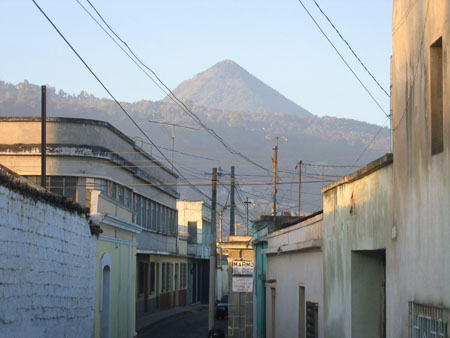
Santa Maria viewed from the north in downtown Xela (or, if you prefer, Quetzaltenango).
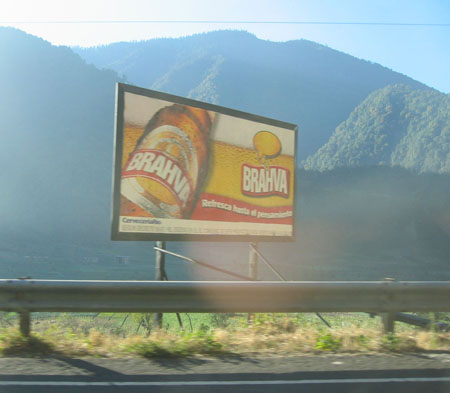
A Brahva billboard on the road from Xela.
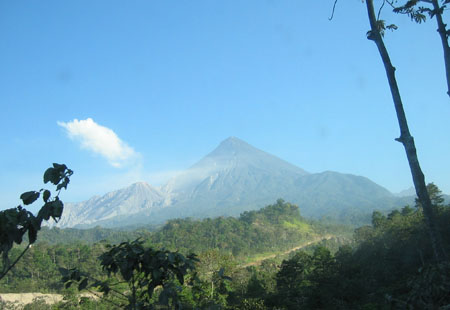
Santa Maria viewed from the south. Santiaguito is the new volcano sprouting from its side. Click to enlarge.
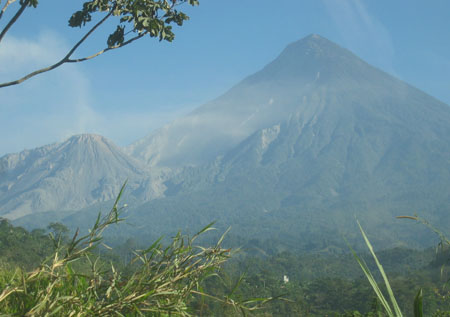
Another view of Santiaguito.
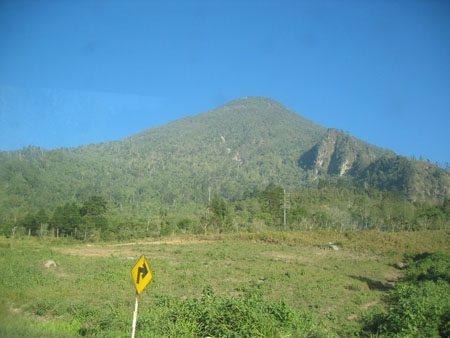
Vegetation growing lusher in the lowlands.
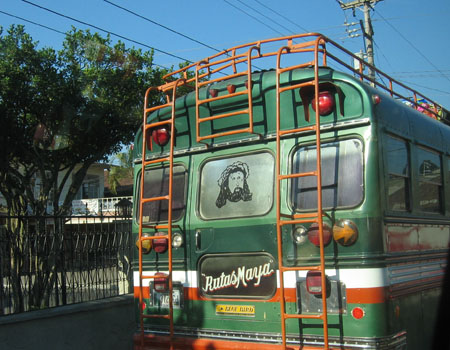
A fat Jesus on the back of a chicken bus.
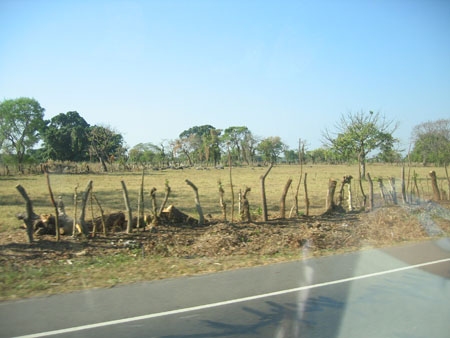
Live sprout fences along the road. These are made by driving freshly-cut live trunks into the ground. They then sprout and can live indefinitely.
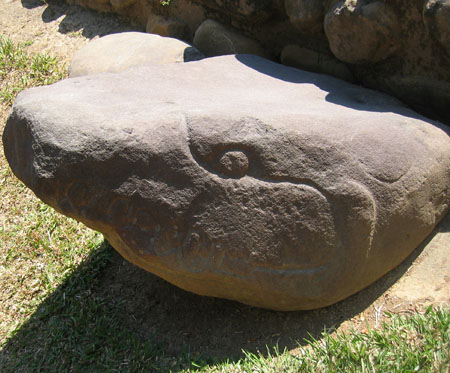
A pre-Mayan crocodile head sculpture at Abaj Takalik.
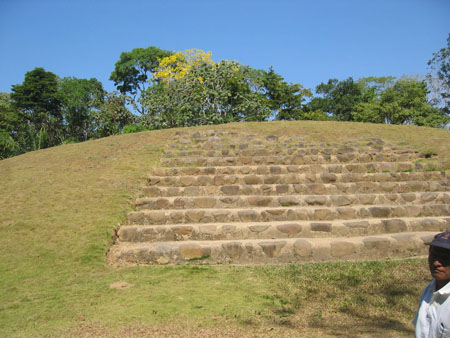
A restored pre-Mayan stepped hillside at Abaj Takalik.
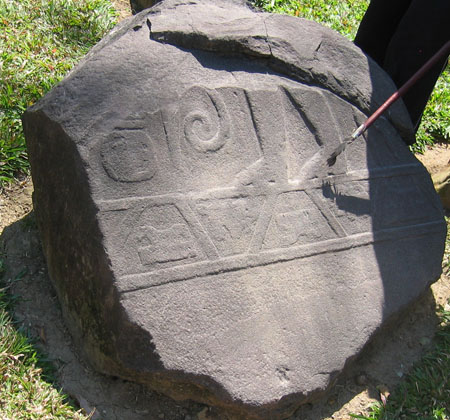
Something definitely manmade among the Abaj Takalik ruins.
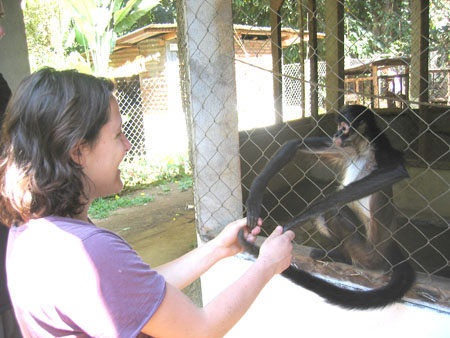
Gretchen with Miss Labia the monkey
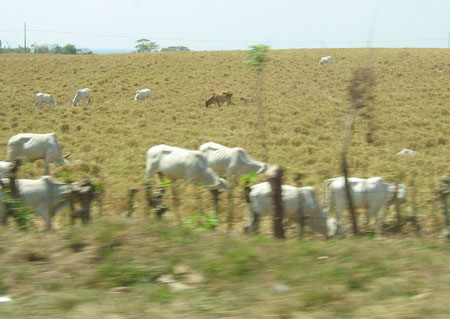
Cows on a ranch in the lowlands. These resemble cows one might see in India.
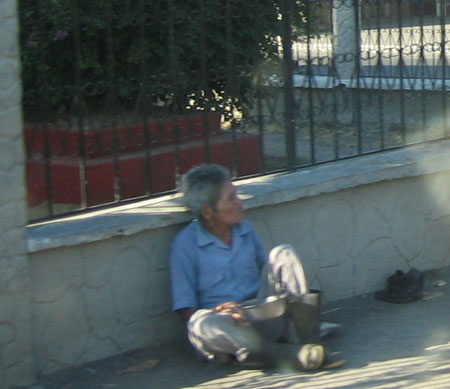
A person on the street in a lowland city.
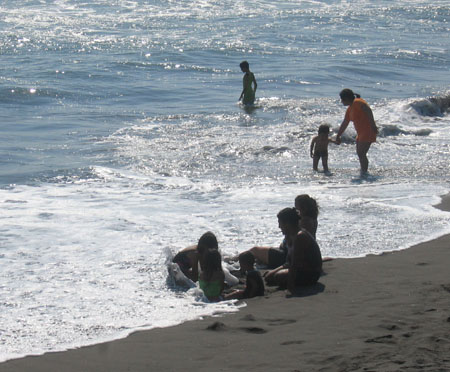
A beach scene in Champerico.
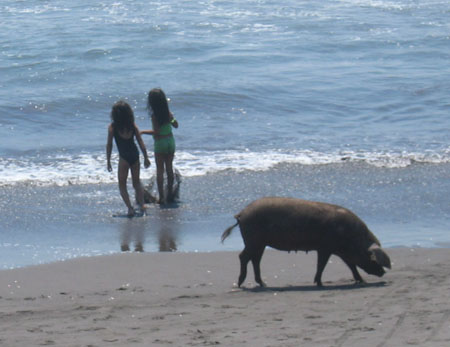
A pig on the beach. (Click to see a movie.)
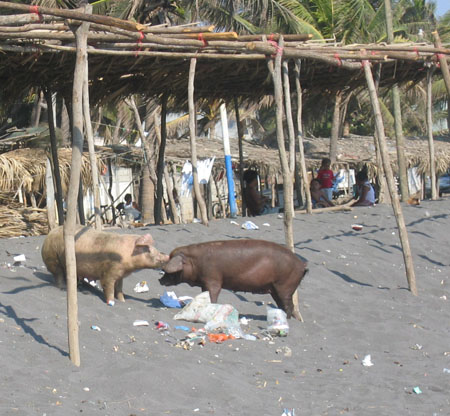
Pigs rooting happily through garbage on the Champerico beach.
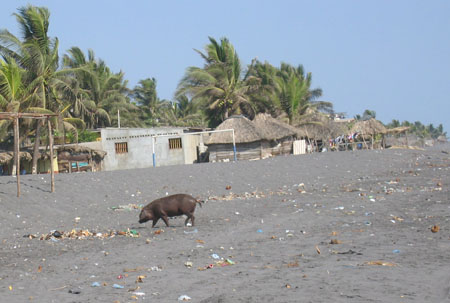
A pig and the palms.
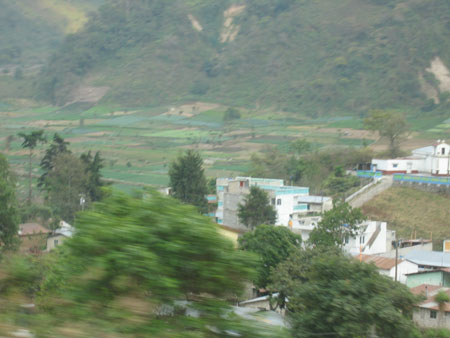
Fields near Xela on the way back "home."
For linking purposes this article's URL is:
http://asecular.com/blog.php?060318 feedback
previous | next |

















